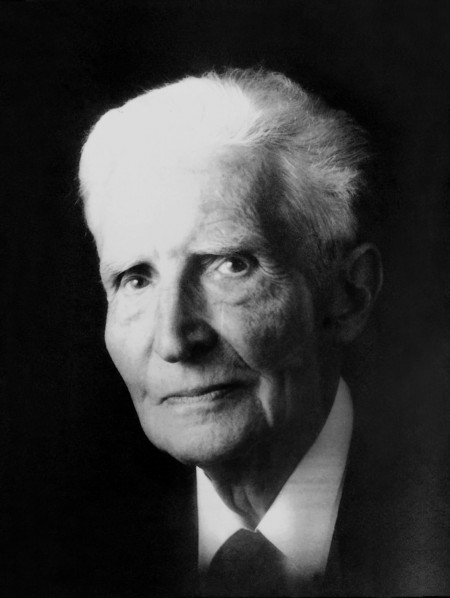
25 April 1906, Budapest - 27 June 1986, Herford
Many people remember to the beginning of the 1970s as a calm and silent period following the completion of the consolidation of Kádár. Though others on the contrary were alarmed by this peaceful resignation and felt behind this that the population of the country, the society was emptied at a large-scale. Zoltán Gárdonyi who was not persuaded by the greatest storms of 20th century history of Hungary to leave his home country decided to do so finally in 1972. For his son had moved abroad earlier already, uniting of his family became an important factor in his decision, which was impossible at home due to the circumstances of that period. He was not retained by the official agencies: the sixty-six years old internationally renowned composer-musicologist and his wife and daughter were given regular evacuation permission. The Federal Republic of Germany became their new home country.
Zoltán Gárdonyi was born in Budapest to a music lover-musician family. His father, Albert Gárdonyi, was a noted historian and amateur violinist, who supported wholeheartedly the unfolding of the musical talent of his son in his entire life. His mother, Mária Weigl pianist graduated from the Academy of Music in 1903 as a class-mate of Béla Bartók. By different musician acquaintances and friends of his parents, domestic music-making and playing chamber music were everyday experiences for the child Gárdonyi, as a noble tradition of civic life. According to his own words he was deeply impressed in his youth by listening to the playing of the organist of the Calvinist Church at Kálvin square, Gusztáv Krausz, at the Sunday services. The extraordinary skills of Gárdonyi manifested not only in music: by merging the last two academic years at high-school he was permitted to take an early maturation exam at the age of seventeen, so that Zoltán Kodály could admit him as a student of composition at the Academy of Music in the Fall of 1923, after an introductory visit prior to that. He pursued music history and ethnomusicology studies under the guidance of Arnold Schering and Erich von Hornbostel at the musicology department of the Friedrich Wilhelm University of Berlin from 1927, then parallel with that he became a student of Paul Hindemith at the composition department of the Hochschule für Musik in Berlin between 1928 and 1930. The triple roots of his years of study determined Gárdonyi's entire work: the two wholly different schools of composition (Kodály – Hindemith) and the world-famous department of musicology at the university in Berlin, where he defended his doctoral dissertation (Die ungarischen Stileigentümlichkeiten in den musikalischen Werken F.Liszts) successfully. Gárdonyi was the third one after Bence Szabolcsi and Dénes Bartha also graduated in Berlin, who could mediate the results, methods and tools of German musicology to Hungary, possessing a doctorate earned from a German university.
As a composer-musicologist he taught first class singing and music lessons at the Lutheran Teachers' Training Institute of Sopron (1931–1941), and led the Liszt Ferenc Music Association for seven years (1931–1938). He found a real home in the town's rich life of chamber music and soon became the most preferred accompanist of that. Besides playing the classical chamber repertoire he had the possibility of performing his own works, as well. Between 1941 and 1969 he taught at the Academy of Music, and from 1946 he became a full professor there. Due to his versatile personality and qualifications he taught several courses besides his main fields, music theory and music history. His work as a pedagogue was characterized by a unique methodical approach. From 1946 to the ‘year of the change' (1948) he led the protestant sacred music department of the Academy. Following the termination of that department he could teach only secondary subjects and his works received condemnatory words in newspaper articles, though despite all these he remained a committed devotee of the renewal of the protestant church music. Between 1949 and 1953 he taught church singing and music at the Calvinist Theology Academy, and he was the editor of the first Calvinist Choral Collection for national use in 1959.
Gárdonyi's oeuvre consists of hundreds of compositions (orchestral, chamber, piano, organ and vocal works), several scientific studies and books. His writings on Liszt (Distance-based phenomena in the music of Liszt, 1959; Nationale Thematik in der Musik F. Liszts bis 1848, 1963; Neue Tonleiter- und Sequenztypen in den Frühwerken F. Liszts, 1978; Neue Ordnungsprinzipien der Tonhöhen in Liszts Frühwerken, 1978), and on Bach's contrapuntal art (The fundamentals of the contrapuntal art of J. S. Bach,1967; The canon and fugue constructing art of J. S. Bach, 1972), as well as his books on musical forms for pedagogic aims (The World of Musical Forms,1949; Analytical Study of Musical Forms,1963, 1979) worth mentioning. He published several piano works of Liszt with István Szelényi, and edited the first series of the New Complete Edition of the works of Liszt together with him, the first series of (Neue Liszt Ausgabe; Werke für Klavier zu zwei Händen).
His creative impetus was not broken during his voluntary exile in Germany, a series of important works were composed over the last one and a half decades of his life: Memento (cantata, 1975), Third Sonata for Organ (1983), Bipartita (for two organs, 1983), The Song of Gábor Bethlen (mixed choir, trumpet, 3 trombones / mixed choir, organ, 1980), Meditatio in memoriam Z. Kodály (organ, 1972/1982).
R. P.


